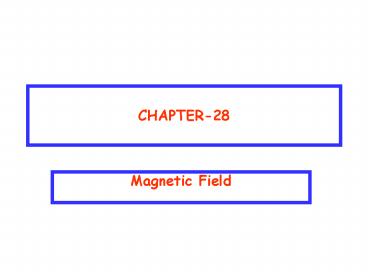Magnetic Field - PowerPoint PPT Presentation
1 / 10
Title:
Magnetic Field
Description:
Electric field E produces a electric force FE on a stationary charge q ... If v has a component along B then particle trajectory is a helix (helical path) ... – PowerPoint PPT presentation
Number of Views:223
Avg rating:3.0/5.0
Title: Magnetic Field
1
CHAPTER-28
- Magnetic Field
2
Ch 28-2 What produces a Magnetic Field?
- Electric field E produces a electric force FE on
a stationary charge q - Magnetic field B produces a magnetic force FB on
a moving charge q - What produces a Magnetic Field? A Magnetic
Monopole? Magnetic monopoles do not exists - Two ways to produce magnetic field B
- Electromagnet magnetic field due to a current
- Permanent magnet net magnetic field due to
intrinsic magnetic field of electrons in certain
material.
3
Ch 28-3 The Definition of B
- Electric field E
- E field is tested by measuring force FE on a
static charge q - EFE/q
- Magnetic Field B is tested by measuring force FB
on a moving charge q. If v is charge velocity
then - FBq(vxB)qvBsin?
- is angle between the v and B.
- Direction of B that direction of V for which
FB0 - Direction of FB ? to plane of V and B
4
Ch 28-3 The Definition of B
- Unit of B Tesla (T)
- BFB/qvsin?
- SI unit of magnetic field B (T)Newtons/Coulomb.(m
/s) - N/(C/s).mN/A.m
- 1T1N/A.m
- Magnetic Field Lines
- B field line starts from N pole ans terminates at
S pole - Like magnetic pole repel each other and opposite
pole attract each other.
5
Ch 28-4 Crossed Fields
- Crossed fields
- a region with E and B field ? to each other.
- If the net force due to these two fields on a
charge particle is zero, particle travels
undeviated - Then FEFB
- qEqvB (?90)
- EvB or vE/B
6
Ch 28-6 A Circulating Charged Particle
- When a charge q moves in a B field then the
magnetic force FBqvBsin?qvB (?90) - For ?90 the particle moves in a circular orbit
wit a radius given by FRFB - mv2/RqvB (m is particle mass)
- Rmv/qB or vqRB/m
- Particle period T2?R/v
- Frequency f1/Tv/2?R
- Angular frequency ?2?f
- ?2?fv/RqB/m
- If v has a component along B then particle
trajectory is a helix (helical path)
7
Ch 28-8 Magnetic Force on a Current-Carrying Wire
- A force is exerted by a magnetic field B on a
charge q moving with velocity v. - Direction of force is same for an electron (-q)
moving with velocity vD( in opposite direction to
v). - For a wire carrying a current i, number of
electrons passing a length of wire L in time t
are q-given by - q-itiL/vD q- -q and vD-v
- q-iL/vD reduces to qiL/v
- Then FBq(vxB) (iL/v)(vxB)
- FB i(LxB)
- FB iLB
8
Ch 28-9 Torque on a Current Loop
- A current carrying rectangular loop placed
between the N and S poles of a magnet, no
magnetic force on shorter sides but forces in
opposite direction on longer sides
9
Ch 28-9 Torque on a Current Loop
Same Magnitude of forces F2 and F4 on shorter
sides F2F4ibBcos? Same Magnitude of forces F1
and F3 on shorter sides F1F3iaBsiniaB Net
torque due to F1 and F3 is ? iaB x (bsin?/2)
iaB x (bsin?/2) iabBsin? ? iABsin? i(AxB)i?
10
Ch 28-10 Magnetic Dipole Moment
- Magnetic moment of a coil
- ?NiA ( A is coil area)
- Then ? ? x B NiAB sin?
- Torque ? exerted on an electric dipole p in an
electric field E ? p x E - Torque due to electric or magnetic field vector
product of dipole moment and field vector - Electric potential energy U(?) of a electric
dipole moment p in an E field U(?) -p.E - Magnetic potential energy of a magnetic dipole ?
- U(?) - ? . B - ? B cos?
- Max. value of U(?) for ? 180
- Min. value of U(?) for ? 0
- Work done by a magnetic field in rotating a a
magnetic dipole from initial orientation ?i to
final orientation ?f W-?U -(Uf-Ui) - Wappl-W































